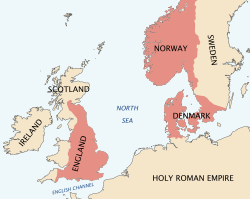
Back إمبراطورية بحر الشمال Arabic Северноморска империя Bulgarian Severská říše Czech Nordsøimperiet Danish Nordseereich German Αυτοκρατορία της Βόρειας Θάλασσας Greek Imperio del mar del Norte Spanish Põhjamere impeerium Estonian امپراتوری دریای شمال Persian Pohjanmeren valtakunta Finnish
North Sea Empire | |||||||||||||||||
|---|---|---|---|---|---|---|---|---|---|---|---|---|---|---|---|---|---|
| 1013–1042 | |||||||||||||||||
 The dominions of Cnut the Great. | |||||||||||||||||
| Status | Personal union of Denmark, Norway and England | ||||||||||||||||
| Capital | Winchester, Wessex, Kingdom of England [1][2][3][4] | ||||||||||||||||
| Common languages | Old Norse, Old English | ||||||||||||||||
| Religion | Christianity, Norse paganism | ||||||||||||||||
| Government | Personal union monarchy | ||||||||||||||||
| King | |||||||||||||||||
• 1013–1014 | Sweyn Forkbeard | ||||||||||||||||
• 1016–1035 | Cnut the Great | ||||||||||||||||
• 1040–1042 | Harthacnut | ||||||||||||||||
| Historical era | Viking Age | ||||||||||||||||
• Sweyn Forkbeard conquers England | 1013 | ||||||||||||||||
| 1016 | |||||||||||||||||
• Cnut the Great became King of Denmark | 1018 | ||||||||||||||||
| 1026 | |||||||||||||||||
• Death of Harthacnut | 1042 | ||||||||||||||||
| |||||||||||||||||
The North Sea Empire, also known as the Anglo-Scandinavian Empire, was the personal union of the kingdoms of England, Denmark[a] and Norway for most of the period between 1013 and 1042 towards the end of the Viking Age.[1] This ephemeral Norse-ruled empire was a thalassocracy, its components only connected by and dependent upon the sea.[2]
The first king to unite all three kingdoms was Sweyn Forkbeard, king of Denmark since 986 and of Norway since 1000, when he conquered England in 1013. He died in the following year, and his realm was divided. His son Cnut the Great acquired England in 1016, Denmark in 1018 and Norway in 1028. He died in 1035 and his realm was again divided, but his successor in Denmark, Harthacnut, inherited England in 1040 and ruled it until his death in 1042. At the height of his power, when Cnut ruled all three kingdoms (1028–1035), he was the most powerful ruler in western Europe after the Holy Roman Emperor.[b]
Cite error: There are <ref group=lower-alpha> tags or {{efn}} templates on this page, but the references will not show without a {{reflist|group=lower-alpha}} template or {{notelist}} template (see the help page).
- ^ Boldt, Andreas D. (2017). Historical Mechanisms: An Experimental Approach to Applying Scientific Theories to the Study of History. Routledge. pp. 125, 196.
- ^ Murphy, Terence R. (1998). Magill, F. N. (ed.). Canute the Great. Vol. 2: The Middle Ages. Routledge. pp. 201–205.
{{cite book}}:|work=ignored (help) - ^ Larson, Laurence Marcellus (1912). Canute the Great: 995 – 1035 and the Rise of Danish Imperialism During the Viking Age. New York: Putnam. p. 257. OCLC 223097613.